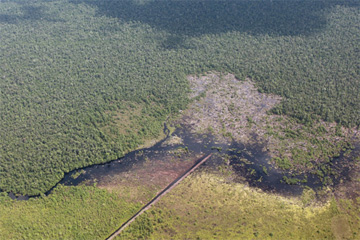Indonesia’s decision earlier this year to allow conversion of up to 2 million hectares of peatlands for oil palm plantations is “a monumental mistake” for the country’s long-term economic prosperity and sustainability, argues an editorial published in the June issue of Frontiers in Ecology and the Environment.
Lian Pin Koh of ETH Zurich, Corey J.A. Bradshaw of the University of Adelaide, and I cite five reasons why the move is a counterproductive one for Indonesia.
First, draining of peatlands to the depth of 60-80 cm recommended for oil palm cultivation will trigger an immense release of carbon into the atmosphere, exacerbating, rather than mitigating, global warming. While burning releases enormous amounts of carbon dioxide, merely draining peatlands also contributes to global warming — upon exposure to air, peat rapidly oxidizes, decomposes, and releases carbon dioxide. A study led by Dr. Susan Page University of Leicester found that producing one ton of palm oil on peatland generates 15 to 70 tons of CO2 over 25 years as a result of forest conversion, peat decomposition and emission from fires associated with land clearance.
 Draining and clearing of peat forest in Central Kalimantan. Photo by Rhett A. Butler. |
Second, peatlands are formed by hundreds to thousands of years of accumulation of dead vegetation. Thus recovery after degradation and destruction will take generations. In the meantime the services afforded by peatlands, including locking up vast amounts of carbon and acting as a “sponge” to reduce the incidence of flooding, will be reduced or non-existent.
Third, swamp forests growing on peatlands are highly biodiverse ecosystems supporting a wide range of plant and animal life, including endangered orangutans. Conversion to oil palm will drastically reduce species richness (recent research has shown that conversion of primary rainforest to an oil palm plantation results in a loss of more than 80 percent of species).
Fourth, degradation of peatlands will increase the incidence of “haze” that results from peat fires. Past haze events — especially during the el Niñe of 1997-1998 — show that peat fires carry substantial economic, health, and political costs.
Fifth, conversion of Indonesia’s most carbon-dense ecosystems reduces the country’s potential to earn compensation under the proposed REDD mechanism for reducing carbon emissions from deforestation and forest degradation. Forest conservation for REDD could prove to be an attractive form of land use on peatlands, competitive economically with returns from palm oil production.
We conclude by proposing that (1) Indonesia postpone its final decision on peatlands until after U.N. climate talks in Copenhagen this December; (2) the Roundtable
on Sustainable Palm Oil “stipulate that, as a criterion for certified sustainable palm oil, plantations may not be converted from peatlands”; and (3) environmental scientists “immediately start mapping all peatlands in Indonesia to facilitate the identification and exposure of companies planning to develop oil palm plantations on peatlands, to the detriment of the country’s long-term sustainability”.
Lian Pin Koh, Rhett A Butler, and Corey JA Bradshaw. Conversion of Indonesia’s peatlands. Frontiers in Ecology and the Environment. June 2009. doi: 10.1890/09.WB.013







